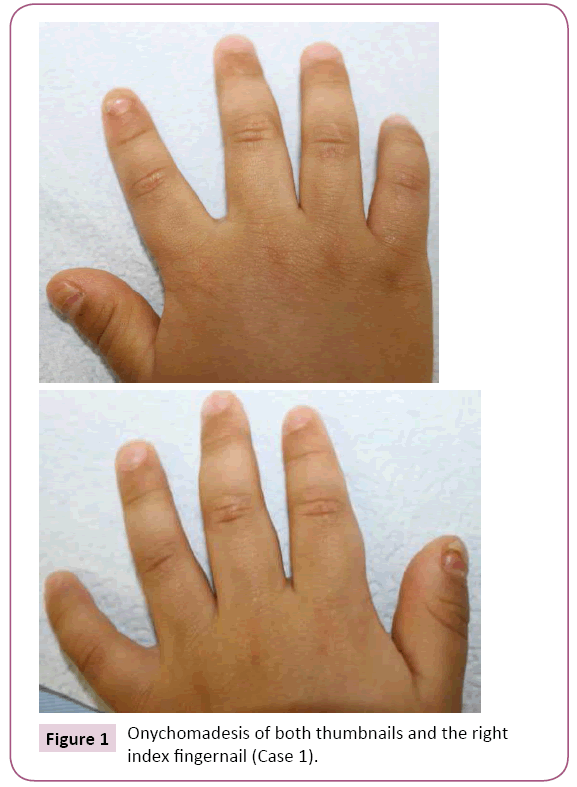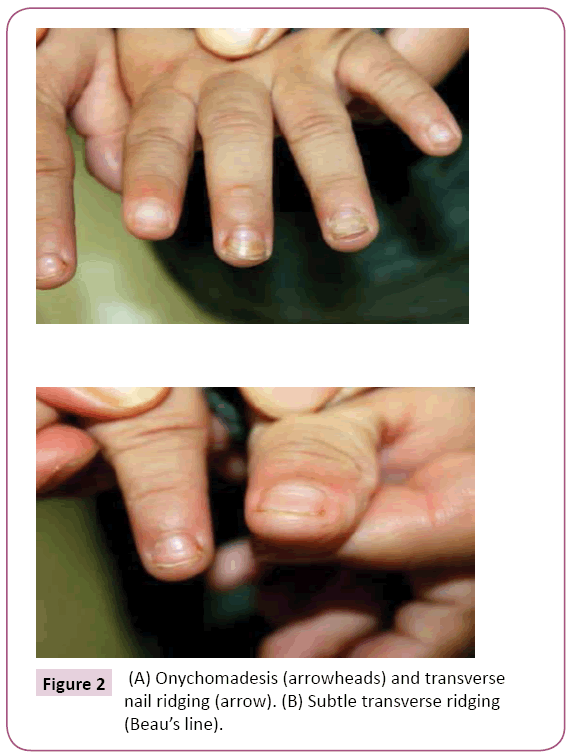Min Woo Kim, Bo Ri Kim, Sang Young Byun, Hyun-sun Yoon, Soyun Cho and Hyun-sun Park*
Department of Dermatology, Seoul National University Boramae Hospital, Seoul, Korea
- *Corresponding Author:
- Hyun-sun Park
Department of Dermatology, Seoul National University Boramae Hospital, 425, Shindaebang-2-dong, Dongjak-gu, Seoul, 156-707, Korea
Tel: 82-2-870-2880
Fax: 82-2-831-0714
E.mail: snuhdm@gmail.com
Received Date:October 02, 2015; Accepted Date: October 16, 2015; Published Date: September 09 2015
Citation: Min Woo Kim, Bo Ri Kim, Sang Young Byun, et al. Beau’s Line and Onychomadesis after Hand-Foot-Mouth Disease. Clin Pediatr Dermatol. 2016, 1:1 doi: 10.21767/2472-0143.100001
Hand-foot-mouth disease (HFMD) is caused by enterovirus or Coxsackie virus (CV) infection. It is characterized by palmoplantar vesiculopustular eruption and erosive stomatitis [1], which enables differential diagnosis from herpangina, aphthous stomatitis, and Kawasaki disease. There are several case reports on the nail presentation of HFMD [1-10], but some clinicians are not yet familiar with this phenomenon and can make a misdiagnosis leading to unnecessary treatment. Herein we report two cases of onychomadesis that developed after HFMD. The first case was a 26-month-old boy who presented with a nail deformity on October 2, 2013. His mother mentioned that she found the deformity 1 week prior. His past medical history was insignificant except for previous febrile HFMD that was diagnosed by a local pediatrician in August. There was no history of nail trauma, previous hand dermatitis, or drug use other than acetaminophen during the course of the febrile HFMD. Laboratory test results, including complete blood cell count, admission panel, zinc, magnesium, iron, and ferritin levels, were within normal limits. Physical examination showed shedding of both thumbnails and the right index fingernail with normal proximal regrowth (Figure 1). His toenails appeared normal. The second case was a 25-month-old boy who presented with a similar nail deformity on October 30, 2013, which developed 1 month previously. His past medical history was insignificant except for nonfebrile HFMD in August. Laboratory test results, including complete blood cell count, admission panel, and zinc and ferritin levels, were within normal limits. There was no history of nail trauma, previous hand dermatitis, or drug use. Physical examination showed subtle transverse ridging of the fingernails and shedding of the toenails and fingernails with normal proximal regrowth (Figure 2).
Cases and Methods
Hand-foot-mouth disease (HFMD) is caused by enterovirus or Coxsackie virus (CV) infection. It is characterized by palmoplantar vesiculopustular eruption and erosive stomatitis [1], which enables differential diagnosis from herpangina, aphthous stomatitis, and Kawasaki disease. There are several case reports on the nail presentation of HFMD [1-10], but some clinicians are not yet familiar with this phenomenon and can make a misdiagnosis leading to unnecessary treatment. Herein we report two cases of onychomadesis that developed after HFMD. The first case was a 26-month-old boy who presented with a nail deformity on October 2, 2013. His mother mentioned that she found the deformity 1 week prior. His past medical history was insignificant except for previous febrile HFMD that was diagnosed by a local pediatrician in August. There was no history of nail trauma, previous hand dermatitis, or drug use other than acetaminophen during the course of the febrile HFMD. Laboratory test results, including complete blood cell count, admission panel, zinc, magnesium, iron, and ferritin levels, were within normal limits. Physical examination showed shedding of both thumbnails and the right index fingernail with normal proximal regrowth (Figure 1). His toenails appeared normal. The second case was a 25-month-old boy who presented with a similar nail deformity on October 30, 2013, which developed 1 month previously. His past medical history was insignificant except for nonfebrile HFMD in August. Laboratory test results, including complete blood cell count, admission panel, and zinc and ferritin levels, were within normal limits. There was no history of nail trauma, previous hand dermatitis, or drug use. Physical examination showed subtle transverse ridging of the fingernails and shedding of the toenails and fingernails with normal proximal regrowth (Figure 2).
Figure 1: Onychomadesis of both thumbnails and the right index fingernail (Case 1).
Figure 2: (A) Onychomadesis (arrowheads) and transverse nail ridging (arrow). (B) Subtle transverse ridging (Beau’s line).
Discussion
HFMD has been associated with nail matrix arrest [2,11]. Beau’s line is defined as a transverse groove resulting from temporary interruption of the nail plate formation [1]. Onychomadesis is considered an extreme form of Beau’s line with subsequent separation of the nail plate [1]. Nail matrix forms the hard nail plate, and events affecting nail matrix may cause incomplete nail plate formation such as Beau’s lines or onychomadesis. Several proposed etiologies of these changes include drug exposure (Chemotherapy, anti-epileptic drugs, retinoids), infection, fever, systemic diseases, and nutritional deficiency [1,12]. The mechanism of nail matrix arrest has not yet been elucidated. Inhibition of cellular proliferation or a different quality (thinner and dystrophic) of the produced nail during the event are plausible hypotheses [2]. Several reports describe nail matrix arrest after HFMD, but its mechanism remains unclear. A recent prospective study observed a 5-year-old boy with HFMD who developed onychomadesis only on the nails having cutaneous HFMD lesions and suggested that nail dysfunction due to direct inflammation spreading from skin eruptions around nail is among the causes of onychomadesis linked to HFMD [5]. Nail matrix arrest recovers and normal nail regrowth usually occurs after several weeks [1,2,5]. Various viruses, including CVA6, CVA10, CVA16, CVB1, CVB2, and an unidentified non-polio enterovirus, are reported pathogens associated with a nationwide outbreak of HFMD-related onychomadesis [1]. The absence of onychomadesis in HFMD epidemics caused by other viral strains (enterovirus 71 in Southeast Asia) supports the hypothesis that specific strains are responsible for this manifestation [13]. Furthermore, nail matrix arrest develops more frequently in HFMD patients with CVA6 infection than in HFMD patients with non-CVA6 infection (37% vs. 5%, p<0.05) [14]. Unfortunately, in the present two cases, pathogens from previous HFMD could not be identified. However, their nail changes probably resulted from previous HFMD during the summer, the epidemic period of HFMD in Korea, and they were likely infected with the viral strain that is able to induce nail matrix arrest. We also performed blood tests to exclude other etiologies which enable nail changes including nutritional deficiency in our cases. Although the causes of presented nail deformities could not be definitely proven, the temporal relationship and the absence of possible causes of nail matrix arrest other than HFMD support this suggestion.
Conclusion
Clinicians should be aware of nail changes after HFMD because they can be easily overlooked and underestimated owing to latency. Further studies are required to elucidate the exact pathomechanismn of HFMD-associated nail matrix arrest.
References
- Bettoli V, Zauli S, Toni G, Virgili A (2013) Onychomadesis following hand, foot, and mouthdisease: a case report from Italy and review of the literature. Int J Dermatol 52: 728-730.
- Clementz GC, Mancini AJ (2000) Nail matrix arrest following hand-foot-mouth disease: areport of five children. PediatrDermatol 17: 7-11.
- Davia JL, Bel PH, Ninet VZ, Bracho MA, Gonzalez-Candelas F et al (2011) Onychomadesisoutbreak in Valencia, Spain associated with hand, foot, and mouth disease caused byenteroviruses. PediatrDermatol 28: 1-5.
- Tay L, Lee SJ (2013) Onychomadesis following childhood hand-foot-mouth disease in twopairs of siblings- a familial predisposition? Dermatol Online J 19: 20036.
- Shikuma E, Endo Y, Fujisawa A, Tanioka M, Miyachi Y (2011) Onychomadesis developedonly on the nails having cutaneous lesions of severe hand-foot-mouth disease. Case RepDermatol Med: 324193.
- Shin JY, Cho BK, Park HJ (2014) A Clinical Study of Nail Changes Occurring Secondary toHand-Foot-Mouth Disease: Onychomadesis and Beau's Lines. Ann Dermatol 26: 280-283.
- Apalla Z, Sotiriou E, Pikou O, Lefaki I, Lallas A, et al. (2015) Onychomadesis after hand-footand-mouth disease outbreak innorthern Greece: case series and brief review of theliterature. Int J Dermatol 54: 1039-1044.
- Miyamoto A, Hirata R, Ishimoto K, Hisatomi M, Wasada R, et al. (2014) An outbreak ofhand-foot-and-mouth disease mimicking chicken pox, with a frequent association of onychomadesis in Japan in 2009: a new phenotype caused by coxsackievirus A6. EurJDermatol 24: 103-104.
- Kim EJ, Park HS, Yoon HS, Cho S (2014) Four cases of onychomadesis after hand-footmouthdisease. Ann Dermatol 26: 777-778.
- Liang KT, Joyce SSL (2012) Onychomadesis associated with childhood hand-foot-mouthdisease. Proceedings of American Academy of Dermatology 66: Supplement 1.p: AB99.
- Bernier V, Labreze C, Bury F, Taieb A (2001) Nail matrix arrest in the course of hand, footand mouth disease. Eur J Pediatr160: 649-651.
- Scheinfeld N, Dahdah MJ, Scher R (2007) Vitamins and minerals: their role in nail healthand disease. J Drugs Dermatol 6: 782-787.
- Chan KP, Goh KT, Chong CY, Teo ES, Lau G, et al. (2003) Epidemic hand, foot and mouthdisease caused by human enterovirus71, Singapore. Emerg Infect Dis 9: 78-85.
- Wei SH, Huang YP, Liu MC, Tsou TP, Lin HC, et al. (2011) An outbreak of coxsackievirus A6hand, foot, and mouth disease associated with onychomadesis in Taiwan, 2010. BMC InfectDis 11: 346.



